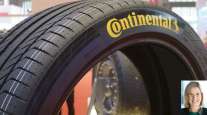Staff Reporter
Idaho Rolling Out $1.2 Million Tire Inspection Sensor System

[Stay on top of transportation news: Get TTNews in your inbox.]
Tires on commercial vehicles traveling through Idaho’s ports of entry are coming under new scrutiny with the state transportation department rolling out a $1.2 million system of inspection sensors.
The Idaho Transportation Department board approved using unallocated funds for safety improvement to install new Tire Anomaly and Classification Systems at the state’s ports of entry, Craig Roberts, ITD commercial vehicle services manager, told Transport Topics.
“The driving public is much safer when commercial vehicles with tire issues are stopped to correct blowouts, flats or missing tires,” Roberts said. “Installing TAC systems is a proactive approach to safety.”
More than 1,100 tire anomalies have been detected since Idaho’s first TAC system was installed in February at the Declo Port of Entry 3 miles west of the junction of interstates 84 and 86.

Roberts
“It is important for all highway users to be safe while on the roadway. ITD is looking out for both drivers and public users by ensuring commercial vehicle tires are in good shape to continue their journey,” he added.
State officials inspect commercial vehicles at Idaho’s ports of entry to identify safety issues. The state’s ports of entry weigh more than 3.75 million trucks annually.
“TAC systems are installed in the road and screen semi-truck tires for anomalies and damage. Port employees can use the TAC data to notify truck drivers of damaged or underinflated tires before they cause a safety problem,” ITD explained. “A tire blowout on a semi-truck traveling at highway speeds can be dangerous, even deadly.”
Roberts said the inspections follow federal out-of-service criteria. “Tires will need to be inflated if just low on air or replaced before being allowed to proceed. The [port of entry] will issue warnings for the violations,” he added.
ITD has scheduled new TAC system installations at the ports of entry to coincide with other construction or maintenance work to minimize closures. Below are the expected closure time frames through August.
- Week of May 28: East Boise Port of Entry on I-84 about 11 miles east of Boise in both directions
- June: Inkom Port of Entry 8 miles south of Pocatello on I-15 will have a phased installation. The southbound side is to be completed in June, while the northbound section will be finished next year during interchange construction there.
- Week of July 15: Lewiston Port of Entry at the intersection of U.S. routes 12 and 95 in both directions
- Late July or early August: Sage Junction Port of Entry 8 miles north of Roberts on I-12 in both directions
- August: Huetter Port of Entry 2 miles west of Coeur d’Alene on I-90 in both directions
Roberts cited a national Federal Motor Carrier Safety Administration study about tire problems in commercial vehicle crashes. FMCSA’s 2021 statistics for large truck stated that tires and brake systems were the most common vehicle-related factors for large trucks in fatal crashes.
In a related development, the FMCSA’s Commercial Motor Vehicle Roadside Technology Corridor is studying the effectiveness of tire safety screening systems in a project with states that will be evaluated by the U.S. Department of Energy’s Oak Ridge National Laboratory.

Tires caught by the TAC system. (Idaho Transportation Department)
FMCSA Studies Tire Safety Screening Systems
“Utilizing roadside technology to increase the efficiency of the inspection process by identifying vehicles with potential component violations has been an ongoing challenge. Few systems exist that can accurately determine the presence of a vehicle defect without a visual inspection, including weigh-in-motion, infrared-based screening systems and now tire safety screening systems,” FMCSA stated in a project description.
The study, called “Tire Safety Screening Systems,” will use tire inspection data and information from partnering states to determine if tire screening technology increased the rate of tire violations compared to problem tires identified without any high-tech systems.
“ORNL was previously tasked with identifying the location and effectiveness of the International Road Dynamics Tire Anomaly Classification System (TACS) tire screening system to determine how they were being utilized and what problems existed with the usage of this technology. As part of this task, five states were interviewed to identify how accurate the system was and how the system was used in their state. All the interviewed states had high praise of the system anecdotally, stating that vehicles were flagged frequently and with great accuracy,” FMCSA stated.
FMCSA will issue a final report with its findings that contains a summary and recommendations for ideal use situations and future research areas for tire safety screening technology.
Want more news? Listen to today's daily briefing below or go here for more info:




